 Spyderco‘s new Karahawk is the linguistic blend of Indonesian kerambit (karambit in the Philippines) and hawkbill blade, penned by “little known” designer Sal Glesser. The Karahawk is Spyderco’s second karambit and it is markedly different from the Spyderco/Warren Thomas original all-steel knife design.
Spyderco‘s new Karahawk is the linguistic blend of Indonesian kerambit (karambit in the Philippines) and hawkbill blade, penned by “little known” designer Sal Glesser. The Karahawk is Spyderco’s second karambit and it is markedly different from the Spyderco/Warren Thomas original all-steel knife design.
Mr. Glesser has stated he wanted the Karahawk to be “a simple, compact version designed for very rapid deployment, very secure grip, and quick to the ready.” Intended as a modern, practical interpretation by Glesser, the Karahawk’s blade extends via either its Spyderco Trademark Round Hole or the licensed Emerson Opening Feature (formerly known as The Wave).
Because the Wave feature is the “rapid deployment” method, a right or left tip-up pocket clip rides just below the finger ring. The tip-up orientation is necessary to actuate the Emerson opener against a pocket corner. More on the positive attributes of the clip placement in a minute…
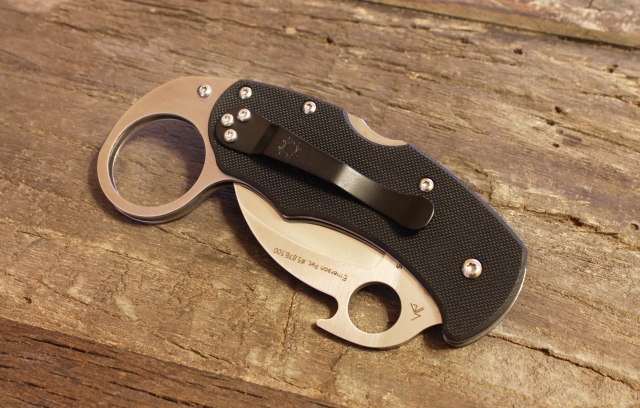 This is a thin knife, with a 5/8″ cross section at its widest point. The abbreviated black USA-made G-10 handle scales are supported by skeletonized stainless steel liners, which continue at the butt to form the 1 1/8″ inner diameter finger ring. Karahawk’s ring is a fraction of the width of the one found on an Emerson Combat Karambit. My eye put the outer edges of the ring at just 3/8″.
This is a thin knife, with a 5/8″ cross section at its widest point. The abbreviated black USA-made G-10 handle scales are supported by skeletonized stainless steel liners, which continue at the butt to form the 1 1/8″ inner diameter finger ring. Karahawk’s ring is a fraction of the width of the one found on an Emerson Combat Karambit. My eye put the outer edges of the ring at just 3/8″.
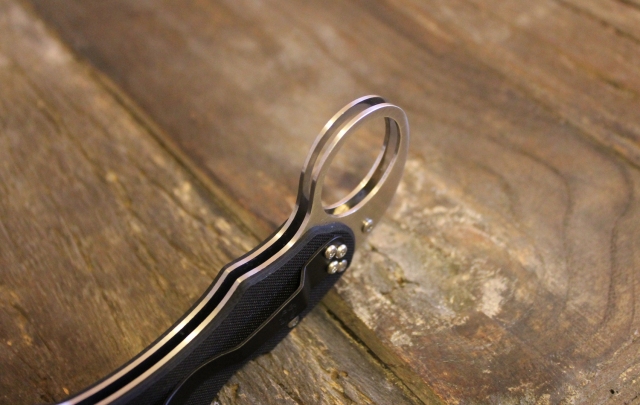
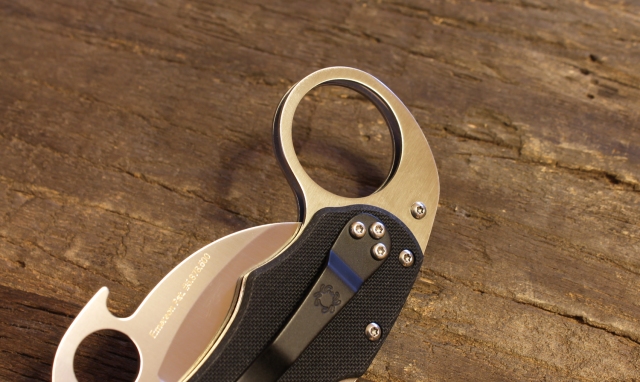 Mr. Glesser is the first to say his Karahawk was not necessarily made for “manipulating.” This means index finger spinning or striking outward from a spin with a karambit. The Karahawk, thusly, has no brake (middle finger notch) for those tempting cool scars for their inner wrists. I admit to flipping karambits for fun. Remember to 1. Keep your forearm perpendicular to the spin of the blade and 2. Relegate this flashy nonsense to the privacy of your own domicile.
Mr. Glesser is the first to say his Karahawk was not necessarily made for “manipulating.” This means index finger spinning or striking outward from a spin with a karambit. The Karahawk, thusly, has no brake (middle finger notch) for those tempting cool scars for their inner wrists. I admit to flipping karambits for fun. Remember to 1. Keep your forearm perpendicular to the spin of the blade and 2. Relegate this flashy nonsense to the privacy of your own domicile.

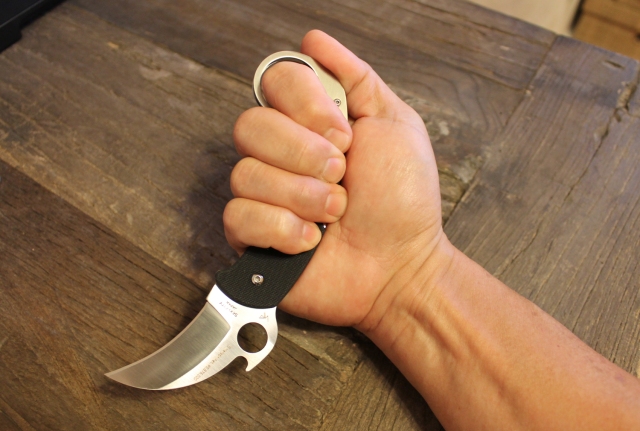 Overall, the Karahawk measures 6 1/2″. It sports a 2 11/32″ premium VG-10 Japanese stainless steel blade. The shallow hawkbill has enough curvature to properly prune vegetation or cut rope, but is not overly radiused. The 1/10″ blade is hollow ground, yet retains good tip strength.
Overall, the Karahawk measures 6 1/2″. It sports a 2 11/32″ premium VG-10 Japanese stainless steel blade. The shallow hawkbill has enough curvature to properly prune vegetation or cut rope, but is not overly radiused. The 1/10″ blade is hollow ground, yet retains good tip strength.
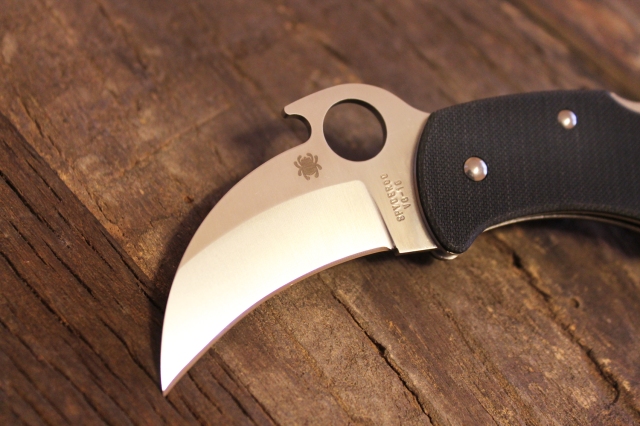

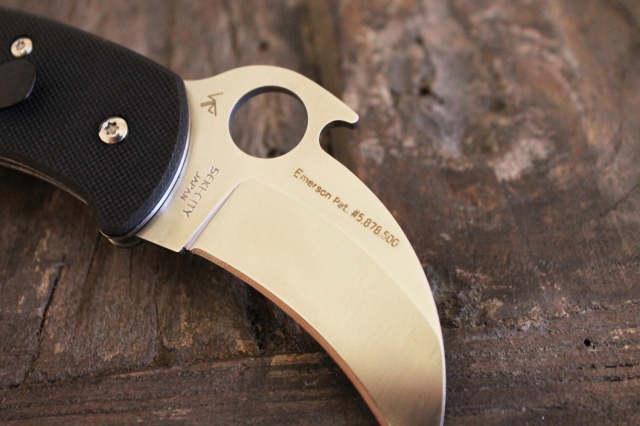 Recognizing the stresses a karambit blade endures, Glesser spec’ed the Karahawk with a lock back mechanism, which he felt was a stronger application than a liner lock or other device. He said he was careful to place the Boye-dented lock lever where palm pressure would not release the blade.
Recognizing the stresses a karambit blade endures, Glesser spec’ed the Karahawk with a lock back mechanism, which he felt was a stronger application than a liner lock or other device. He said he was careful to place the Boye-dented lock lever where palm pressure would not release the blade.
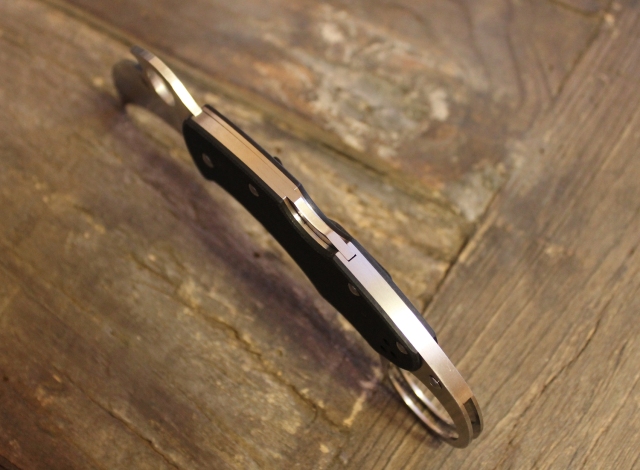 Made in Seki City, Japan, this knife features Old World craftsmanship and tight tolerances. On direct examination, my Karahawk divulged no manufacturing errors. Mr. Glesser says Spyderco has been doing business with a particular Seki City sword/knife maker for 32 years because of their fine work. I’ll buy that (I actually did…).
Made in Seki City, Japan, this knife features Old World craftsmanship and tight tolerances. On direct examination, my Karahawk divulged no manufacturing errors. Mr. Glesser says Spyderco has been doing business with a particular Seki City sword/knife maker for 32 years because of their fine work. I’ll buy that (I actually did…).
I am into my third week of wearing my Karahawk. As I may have said before, I normally pocket carry a blade on my left or support side as a back up to a right side handgun. The Karahawk’s pocket clip allows for two orientations of the knife on either side. With the Emerson hook down toward the pocket corner, dragging the Karahawk out and slightly back will catch the opener at the back seam of the fabric and open the blade.
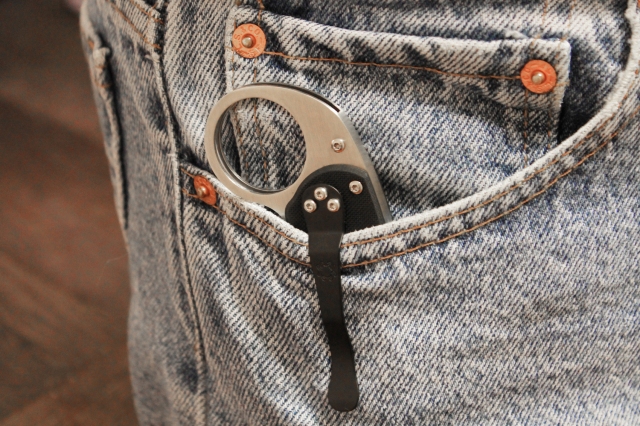 A second way to carry is to have the opener facing forward. In this way, by grasping the ring and rotating the knife outward when you pull up, the hook grabs the side of the pocket as the blade deploys. In a pair of jeans or cargo shorts, I have found this method intuitive. The knife comes out reverse grip, edge out, ready to go!
A second way to carry is to have the opener facing forward. In this way, by grasping the ring and rotating the knife outward when you pull up, the hook grabs the side of the pocket as the blade deploys. In a pair of jeans or cargo shorts, I have found this method intuitive. The knife comes out reverse grip, edge out, ready to go!
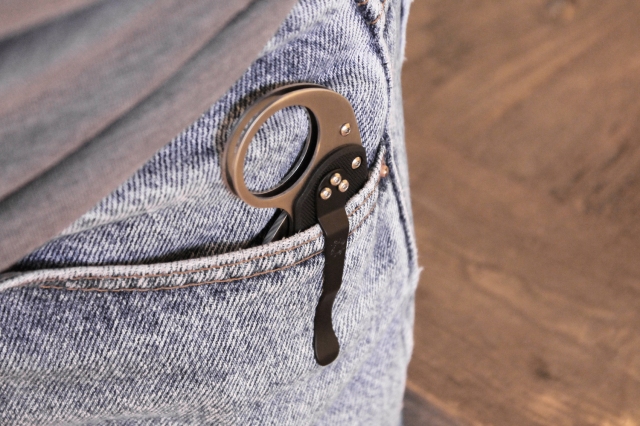 I pre-ordered a Karahawk months ago. It was so far back that I forgot I ordered it. Its arrival was not unwelcome, though. I had seen and handled the knife’s prototype in January at SHOT Show and it was on my must-have list.
I pre-ordered a Karahawk months ago. It was so far back that I forgot I ordered it. Its arrival was not unwelcome, though. I had seen and handled the knife’s prototype in January at SHOT Show and it was on my must-have list.
With a sticker-shocking MSRP of $289.00, Karahawk may induce heart palpitations. While I payed a hundred less than that, it is still a big nut for most of us common squirrels. Mr. Glesser acknowledges the high price, but cites the high quality materials, excellent construction, and power of the Yen as influences to cost.
The Spyderco Karahawk is Sal Glesser’s unapologetic version of the traditional Southeast Asian kerambit, written in today’s hand. It is a nice knife and a solid concept that will surely generate many more kind words of review.
by Wilson

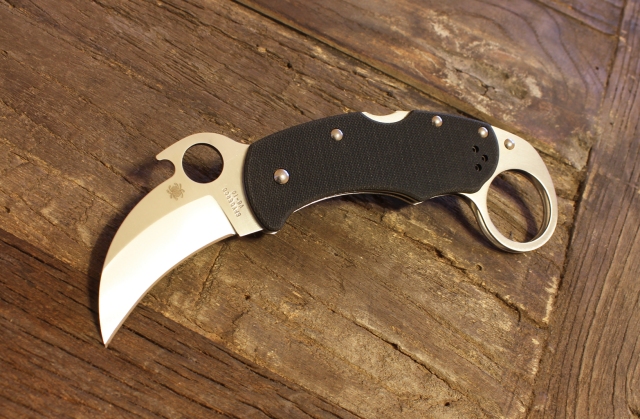
Really great review! I just got this knife the other day and I’m really liking it. The thinness I think is a great attribute. It carries very discretely in the pocket, except for the ring of course.
LikeLike
Thanks, Donovan. Glad you are enjoying yours, too.
Wilson
LikeLike
Quick background: I spent 17 years studying martial arts (10.5 years in Kenpo), and I have a 3rd-degree black belt in Kenpo. That means I am reviewing this from a martial arts weapons (extension of hands in self defense) perspective, as opposed to a “knife collector” perspective. I do own a Fox 599 karambit and some other cheaper versions, so I am also comparing this Karahawk with those other karambits. The Fox 599 (cost $125) also has the Emerson Wave, by the way.
The reason I got the Karahawk knife (for $173 from GP Knives) is because it seemed thinner than other folding karambits that I own, and that thinness piqued my interest because I wanted a lower profile everyday carry folding karambit. Spyderco achieved that thinness by using a lockback mechanism for the lock, instead of a liner lock… which requires a bit more width to accommodate. So here are my thoughts:
Pros: (1) Thin so it is hardly noticeable in pocket; (2) Feels light in hand when performing self defense techniques; (3) The lock back theoretically will be more difficult to accidentally engage during rough use than the liner lock on most other karambits.
Cons: (1) The Emerson Wave feature on the Karambit sticks out a bit too far to hold comfortable in hand in the closed position (vs. the Fox 599). A knife does not have to immediately and always be utilized lethally in self defense. The Fox 599 for example is a decent hunk of metal in your hand when closed, and either end (including the retention ring) can still be used as a blunt force object. Then it can be opened with the Emerson Wave dynamically during motion without changing your grip (if you have it in the reverse grip). However, the Karahawk is a bit too “bulky” to hold comfortably in the closed position as a non-lethal alternative. It is thin, yes… but also a bit “chunky” as measured from the spine to the Emerson Wave feature. (2) The retention ring is not designed for flipping or spinning comfortably. The ring’s dual metal sections are too thin so they cut into the finger when rotating. Now, as a martial artist, I could not care less about continuously spinning karambits (really, it’s not practical)… but practicing flipping out for extension and then back in for retraction is still an important part of knife familiarity in my opinion. And even just flipping once out and once back in is a bit uncomfortable on the finger with the Karahawk. Contrast this with the Fox 599 which has a ring that feels like butter when flipping out for extension.
Overall, so far I like the Karahawk.. and I will certainly use this as my everyday “executive” carry. But it is not the knife I’ll go to when practicing in general either in air or on my body opponent bags at home.
LikeLike
Thanks for your review, Sandan Kenpo. You have more experience in the martial arts arena than I. I like the Fox 599. I got to examine a proto at Blade Show last year. It fits may small/medium hand better than either the Emerson Combat Karambit or the Spyderco Karahawk. I think your comments about the Kara being an “executive carry” to be spot on. Your comments are appreciated!
Wilson
LikeLike